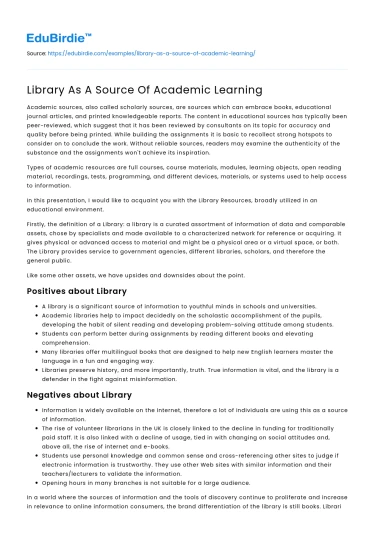Academic sources, also called scholarly sources, are sources which can embrace books, educational journal articles, and printed knowledgeable reports. The content in educational sources has typically been peer-reviewed, which suggest that it has been reviewed by consultants on its topic for accuracy and quality before being printed. While building the assignments it is basic to recollect strong hotspots to consider on to conclude the work. Without reliable sources, readers may examine the authenticity of the substance and the assignments won't achieve its inspiration.
Types of academic resources are full courses, course materials, modules, learning objects, open reading material, recordings, tests, programming, and different devices, materials, or systems used to help access to information.
Save your time!
We can take care of your essay
- Proper editing and formatting
- Free revision, title page, and bibliography
- Flexible prices and money-back guarantee
In this presentation, I would like to acquaint you with the Library Resources, broadly utilized in an educational environment.
Firstly, the definition of a Library: a library is a curated assortment of information of data and comparable assets, chose by specialists and made available to a characterized network for reference or acquiring. It gives physical or advanced access to material and might be a physical area or a virtual space, or both. The Library provides service to government agencies, different libraries, scholars, and therefore the general public.
Like some other assets, we have upsides and downsides about the point.
Positives about Library
- A library is a significant source of information to youthful minds in schools and universities.
- Academic libraries help to impact decidedly on the scholastic accomplishment of the pupils, developing the habit of silent reading and developing problem-solving attitude among students.
- Students can perform better during assignments by reading different books and elevating comprehension.
- Many libraries offer multilingual books that are designed to help new English learners master the language in a fun and engaging way.
- Libraries preserve history, and more importantly, truth. True information is vital, and the library is a defender in the fight against misinformation.
Negatives about Library
- Information is widely available on the Internet, therefore a lot of individuals are using this as a source of information.
- The rise of volunteer librarians in the UK is closely linked to the decline in funding for traditionally paid staff. It is also linked with a decline of usage, tied in with changing on social attitudes and, above all, the rise of internet and e-books.
- Students use personal knowledge and common sense and cross-referencing other sites to judge if electronic information is trustworthy. They use other Web sites with similar information and their teachers/lecturers to validate the information.
- Opening hours in many branches is not suitable for a large audience.
In a world where the sources of information and the tools of discovery continue to proliferate and increase in relevance to online information consumers, the brand differentiation of the library is still books. Libraries must work collectively to 'rejuvenate' the brand. It is not simply about educating students about the library and its physical and electronic resources. The challenge for libraries is to clearly define and market their relevant place in that infosphere—their services and collections both physical and virtual.
References
- https://study.com/academy/lesson/academic-sources-definition-examples-quiz.html






 Stuck on your essay?
Stuck on your essay?

